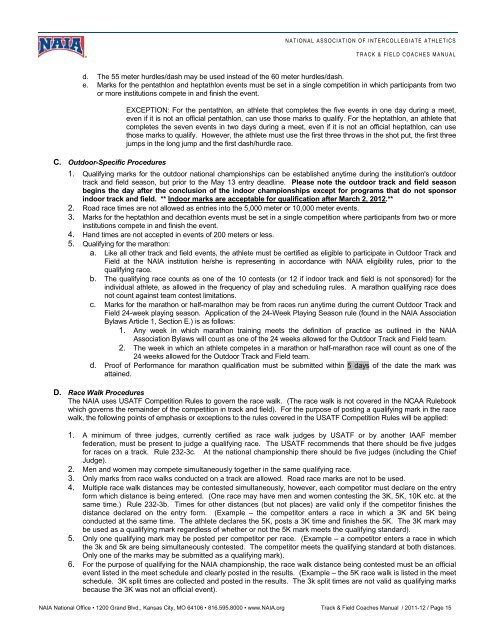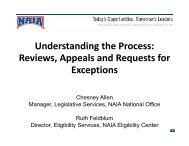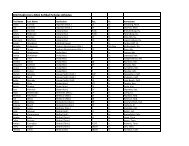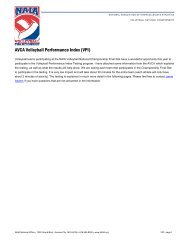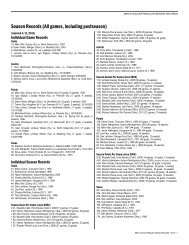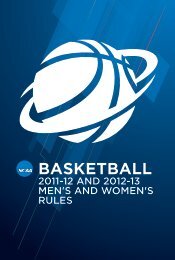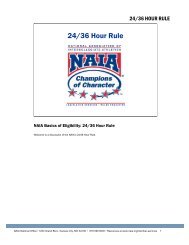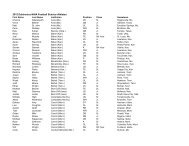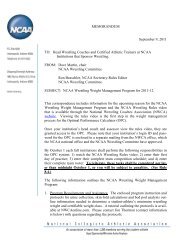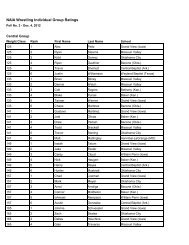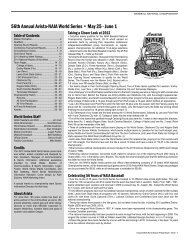Coaches Manual - NAIA
Coaches Manual - NAIA
Coaches Manual - NAIA
- TAGS
- coaches
- manual
- naia
- www.naia.org
You also want an ePaper? Increase the reach of your titles
YUMPU automatically turns print PDFs into web optimized ePapers that Google loves.
NATIONAL ASSOCIATION OF INTERCOLLEGIATE ATHLETICS<br />
TRACK & FIELD COACHES MANUAL<br />
d. The 55 meter hurdles/dash may be used instead of the 60 meter hurdles/dash.<br />
e. Marks for the pentathlon and heptathlon events must be set in a single competition in which participants from two<br />
or more institutions compete in and finish the event.<br />
EXCEPTION: For the pentathlon, an athlete that completes the five events in one day during a meet,<br />
even if it is not an official pentathlon, can use those marks to qualify. For the heptathlon, an athlete that<br />
completes the seven events in two days during a meet, even if it is not an official heptathlon, can use<br />
those marks to qualify. However, the athlete must use the first three throws in the shot put, the first three<br />
jumps in the long jump and the first dash/hurdle race.<br />
C. Outdoor-Specific Procedures<br />
1. Qualifying marks for the outdoor national championships can be established anytime during the institution's outdoor<br />
track and field season, but prior to the May 13 entry deadline. Please note the outdoor track and field season<br />
begins the day after the conclusion of the indoor championships except for programs that do not sponsor<br />
indoor track and field. ** Indoor marks are acceptable for qualification after March 2, 2012.**<br />
2. Road race times are not allowed as entries into the 5,000 meter or 10,000 meter events.<br />
3. Marks for the heptathlon and decathlon events must be set in a single competition where participants from two or more<br />
institutions compete in and finish the event.<br />
4. Hand times are not accepted in events of 200 meters or less.<br />
5. Qualifying for the marathon:<br />
a. Like all other track and field events, the athlete must be certified as eligible to participate in Outdoor Track and<br />
Field at the <strong>NAIA</strong> institution he/she is representing in accordance with <strong>NAIA</strong> eligibility rules, prior to the<br />
qualifying race.<br />
b. The qualifying race counts as one of the 10 contests (or 12 if indoor track and field is not sponsored) for the<br />
individual athlete, as allowed in the frequency of play and scheduling rules. A marathon qualifying race does<br />
not count against team contest limitations.<br />
c. Marks for the marathon or half-marathon may be from races run anytime during the current Outdoor Track and<br />
Field 24-week playing season. Application of the 24-Week Playing Season rule (found in the <strong>NAIA</strong> Association<br />
Bylaws Article 1, Section E.) is as follows:<br />
1. Any week in which marathon training meets the definition of practice as outlined in the <strong>NAIA</strong><br />
Association Bylaws will count as one of the 24 weeks allowed for the Outdoor Track and Field team.<br />
2. The week in which an athlete competes in a marathon or half-marathon race will count as one of the<br />
24 weeks allowed for the Outdoor Track and Field team.<br />
d. Proof of Performance for marathon qualification must be submitted within 5 days of the date the mark was<br />
attained.<br />
D. Race Walk Procedures<br />
The <strong>NAIA</strong> uses USATF Competition Rules to govern the race walk. (The race walk is not covered in the NCAA Rulebook<br />
which governs the remainder of the competition in track and field). For the purpose of posting a qualifying mark in the race<br />
walk, the following points of emphasis or exceptions to the rules covered in the USATF Competition Rules will be applied:<br />
1. A minimum of three judges, currently certified as race walk judges by USATF or by another IAAF member<br />
federation, must be present to judge a qualifying race. The USATF recommends that there should be five judges<br />
for races on a track. Rule 232-3c. At the national championship there should be five judges (including the Chief<br />
Judge).<br />
2. Men and women may compete simultaneously together in the same qualifying race.<br />
3. Only marks from race walks conducted on a track are allowed. Road race marks are not to be used.<br />
4. Multiple race walk distances may be contested simultaneously, however, each competitor must declare on the entry<br />
form which distance is being entered. (One race may have men and women contesting the 3K, 5K, 10K etc. at the<br />
same time.) Rule 232-3b. Times for other distances (but not places) are valid only if the competitor finishes the<br />
distance declared on the entry form. (Example – the competitor enters a race in which a 3K and 5K being<br />
conducted at the same time. The athlete declares the 5K, posts a 3K time and finishes the 5K. The 3K mark may<br />
be used as a qualifying mark regardless of whether or not the 5K mark meets the qualifying standard).<br />
5. Only one qualifying mark may be posted per competitor per race. (Example – a competitor enters a race in which<br />
the 3k and 5k are being simultaneously contested. The competitor meets the qualifying standard at both distances.<br />
Only one of the marks may be submitted as a qualifying mark).<br />
6. For the purpose of qualifying for the <strong>NAIA</strong> championship, the race walk distance being contested must be an official<br />
event listed in the meet schedule and clearly posted in the results. (Example – the 5K race walk is listed in the meet<br />
schedule. 3K split times are collected and posted in the results. The 3k split times are not valid as qualifying marks<br />
because the 3K was not an official event).<br />
<strong>NAIA</strong> National Office • 1200 Grand Blvd., Kansas City, MO 64106 • 816.595.8000 • www.<strong>NAIA</strong>.org Track & Field <strong>Coaches</strong> <strong>Manual</strong> / 2011-12 / Page 15


